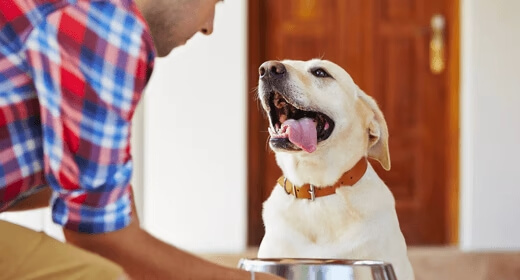

Barking is your dog’s way of communicating. We often observe dogs barking at people and things to grab attention. It is a normal dog behaviour that is often a reflex for expressing emotions related to anxiety, aggression, or boredom. Different types of barks emote different moods and feelings of the dog. Dogs also bark to stop others from entering their territory.
Even though dogs bark to communicate their emotions, excessive barking can cause disturbance to pet parents. In such situations, pet caregivers often look for ways to teach barking on command to their fur babies. If you too want to learn how to stop a dog from barking in the right manner, then read the following.
Dogs often bark to claim territory, express emotions, and communicate with others. However, sometimes, dogs might not know how to control their barking habits. Teaching your pooch to stop barking unnecessarily makes them calmer by sharpening their natural instincts. While barking is a norm for dogs, barking on command is a skill that you easily teach your fur baby. Follow the below points to learn how to teach your dog to stop barking.
Though these tricks will train your canine companion to control its barking habits, you must know that barking is a reflex instinct for dogs. Hence, it is imperative to stay consistent and regular when training a dog. It often takes time for dogs to learn commands and control their instinct to bark. However, with regular practice and consistent effort, you can eventually stop your dog from barking at will.
You can try various methods to stop a dog from barking. Some of these methods include the following:
Yes, dogs generally stop barking once they are exhausted or calmed down.
No, it is better to train the dog to not bark unnecessarily. You can easily do this by training your dog to stay calm.
Dogs are territorial animals who bark at people and other dogs when they feel you are getting in their personal territory.
Dogs can bark for various reasons. Some of the reasons for dogs to bark include:


As a pet parent, do you find yourself wondering, does dog food expire? If so, you’re not alone! In this blog, we will take you through everything you need to know about dog food expiry.
Dogs require a balanced meal every day. As a pet owner, you can choose between dry and wet foods. Dry dog food usually resembles a biscuit or kibble. On the other hand, wet dog food combines meat products or other protein sources with a gravy that incorporates grains, minerals, and vitamins. Whatever your dog finds palatable, make sure their nutritional requirements are met.
Diets that are high in protein are good for dogs. A significant source of energy is found in dietary fats, which are either derived from plant seed oils or animal fats. They offer essential fatty acids, like omega-3s, that are necessary to preserve the health of your dog's skin and coat. Additionally, carbohydrates support your pet's digestive health and provide energy for them to continue with their regular activities.
While it is important to focus on your pet’s daily nutritional intake, you should also make sure that the food packets are still fresh. So, to answer your question, ‘can dogs eat expired food’, the answer is certainly no! It’s because serving expired dog food will deprive your canine companion of the key vitamins and minerals, they need to keep healthy. Hence, it is important to examine the labels and expiration dates before making a purchase.
The amount of time a product is useable and suitable for consumption is referred to as its shelf life. In contrast, expiry date is the last day that a perishable product, like food, will be at its highest quality.
If you are pondering does dog food expire, the answer is a yes. In fact, the contents and types of preservatives used do affect the shelf life of a food item. So, to guarantee your dog's safety, pet food producers set expiration or best by dates. Unopened canned foods have a shelf life of two years from the date of manufacturing, whereas unopened dry pet foods typically have a shelf life of 12 to 18 months. Plan to open and use the dog food before the expiration date. You can usually find this date on the bottom of the can containing dog food.
Now that you know dog food expires, let’s examine the effects of serving expired food to your pet:
After consuming spoiled food, dogs generally exhibit the same gastrointestinal symptoms as people do. These symptoms could include vomiting, diarrhea, and passing wind. Spoiled foods can also contain bacteria that can disturb the equilibrium in the gut and intestines, causing the body to excrete more fluids in an effort to wash them out. What’s more is that moldy dog food can contain mycotoxins like vomitoxin, which can cause serious gastrointestinal disorders.
Dogs can become paralyzed from botulism. It is a rare condition occurring when canines consume contaminated food. The poison gets absorbed in the intestines and passes into the bloodstream, thus paralyzing dogs.
Another consequence of feeding your pet spoiled dog food is malnutrition. Before turning moldy, spoiled foods usually lose their vitamin and mineral value. This suggests that even if the food doesn't upset your dog's stomach, it is still not giving your pet what they require. Your dog may become lethargic if daily nutritional demands aren't met. This can eventually result in bone issues and organ failure, if not recognized as early as possible.
Even if you have a food item that is still within its best by date, improper storage could lead to early contamination and food degradation. Here are some steps you must take to prolong the shelf life and maintain food quality:
Purchasing multiple boxes of treats may save you from making repeat visits to the shop. However, keeping so much stock might increase the likelihood that your dog's food goes bad before it gets completely consumed. Therefore, shop frequently if you don’t want your dog’s food to expire.
The shelf life of fresh, wet items can be increased by keeping them in the freezer. Any unopened canned food should be sealed with plastic wrap and stored in the refrigerator.
Use chip clips to seal the food bags and keep moisture out. You could also store your pet’s food in its original packaging and stack it in a cool, dry place with little exposure to heat and light. Avoid keeping dry dog food open.
Dog food that has expired needs to be tossed out right away. There are also waste management facilities that compost used pet food.
If you're looking for the perfect dog for you, try our Dog Breed Selector today and enjoy a lifetime of tail-wagging joy.